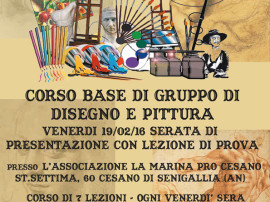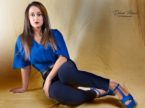Su di me
Mi occupo della gestione e dell'organizzazione dei corsi di Arti figurative (disegno, pittura, grafica, illustrazione e fumetto) nel nuovo studio della NV.art services and communication in Via Bramante, 9/b a Senigallia (AN).
Lavoro come grafico, pittore, illustratore e fumettista.
La NV.art vuole sensibilizzare la popolazione, attraverso la didattica e gli eventi artistico-culturali, ad avvicinarsi al mondo dell'arte, organizzando manifestazioni e meeting culturali (eventi e mostre) per diffondere la conoscenza dell’arte in tutti i suoi molteplici aspetti. L'ambiente è un laboratorio dove vengono affrontati e sviluppati temi che si inseriscono nel campo della comunicazione d'immagine in diversi settori, fornendo servizi di diverso genere come:
Didattica: corsi di arti figurative, grafica, illustrazione e fumetto
Creazione e vendita opere d'arte: quadri, anche su commissione
Progettazione stampati: lavoro di videoimpaginazione, produzione pdf di biglietti da visita, cataloghi, brochure, calendari, progettazione pre-stampa
Organizzazione e allestimento mostre
Organizzazione eventi culturali
Proposte per progetti editoriali
Collaborazione con case editrici, testate giornalistiche
Collaborazione con artisti locali, regionali, nazionali e internazionali per meeting, esposizioni, workshop.
Impianti per cataloghi, manifesti, depliant, biglietti da visita in bianco e nero e a colori progettati con idee creative e con passione
Corsi di disegno
Corsi di pittura ad olio
Corsi di acquerello, tempera, (tecniche miste)
Corsi di grafica (impaginazione, foto ritocco, grafica vettoriale)
Corsi di fumetto
Servizi di pubblicità sul web con internet
Servizi di pre stampa ad aziende ed enti
Opere d’arte (prodotto artistico)
Copie d’autore (prodotto artistico)
L\'ARTE DI MASSIMO NESTI
BIOGRAFIA
Massimo Nesti è nato a Milano il 28 gennaio 1967.
Ha frequentato il Liceo Artistico e l’Accademia di Belle Arti di Brera a Milano , laureandosi in pittura alla cattedra del Prof. Saverio Terruso nel 1991, consegnando una tesi sull’artista Ennio Morlotti e il naturalismo informale.
La sua ricerca si basa sullo studio delle forme del corpo umano avvolte e spezzate da vortici e linee di forza che ne scandiscono il ritmo.
Nel corso dei suoi studi approfondisce e analizza la luce e il colore dei pittori del Seicento: artisti come Caravaggio, Guido Reni, i Carracci, i Bamboccianti ( Peter Van Laer ) saranno oggetto di studi meticolosi.
Nelle opere l’uomo viene visto in continua lotta con gli altri e con sé stesso, partendo da una fase embrionale e giungendo ad una condizione eterea, informale.
In questi vortici, nelle battaglie, l’uomo segue il suo percorso vitale, contrastato e dimenticato ma sempre vivo , con in mente il pensiero di ricongiungersi alla terra, alla natura.
Vive e lavora a Senigallia (AN), organizzando corsi di disegno, pittura, grafica 2d, illustrazione e fumetto al Laboratorio Artistico NV.art services and communication, in Via Bramante, 9/B (http://www.nvart.it) seguendo con passione e professionalità le nuove generazioni di artisti, promuovendo la sua arte, proponendo progetti didattici e formativi per le scuole nel settore della comunicazione d’immagine (illustrazione, fumetto, design).
L’espressione artistica di M.Nesti si concentra su diversi temi: il primo è la ricerca del contatto e della fusione tra uomo e natura, la metamorfosi che vede l’uomo abbracciare e sposare la forma naturale, primordiale dopo essere passato da diversi stadi, da diverse fasi.
In seconda analisi la lotta continua dell’individuo contro gli altri suoi simili presenta un uomo perplesso, capace di reagire ai messaggi dell’ambiente circostante, ma ancora pieno di dubbi e di incertezze, sconcertato dagli avvenimenti del mondo esterno.
Quindi sorge un desiderio recondito da parte dell’individuo di chiedere a sé stesso se la strada che sta percorrendo è quella giusta , se vale la pena di combattere tutte le battaglie o al contrario posarsi sulla natura e amalgamarsi ad essa senza colpo ferire.
La figura dell’uomo che l’artista presenta compie un cammino fitto di ostacoli e difficoltà di ogni genere e tende sempre a ritornare sui suoi passi per non tradire la sua coscienza e le sue passioni.
La materia si plasma e si evolve attraverso ellissi e forme embrionali che sfociano in gesti, mani, corpi ed espressioni sofferenti che vengono lievemente percepite attraverso la composizione e che riflettono il periodo di violenza odierno.
C’è una particolare ricerca dell’artista nell’infondere e comunicare al fruitore uno sorta di equilibrio nei combattimenti, nelle lotte, negli studi di cromie vegetali che ricordano le tonalità di un bosco, di una siepe, di una foglia: è un inno all’unione dell’uomo con la natura, al corpo in carne ed ossa che si unisce all’albero, al sangue che si mescola con la linfa del ramo.
Le diverse materie si fondono durante la lotta: le braccia che, con ardore, sferrano i colpi mortali tendono, durante il loro movimento, a trasformarsi in rami che, con un abbraccio inconsueto, mostrano orgogliosi il loro verde fogliame.
La ciclicità vitale dell’individuo viene qui descritta in maniera capillare dall’artista, che segue una sua logica di trasformazione, di cambiamento attraverso il tema della lotta e del combattimento risolti dapprima in maniera chiaroscurale, poi usando cromie che a poco a poco sfioreranno i colori della natura, dell’acqua e della terra sino ad impadronirsene totalmente.
L\'ARTE DI MASSIMO NESTI (in inglese)
‘Real’ Present and Remote’
M. Nesti’s personal work wants to transmit and above all, simply communicate the feeling of inner discomfort that people perceive living in a modern and technological society.
In the work, man is seen in a continuous struggle with others and himself, beginning from a embryo like stage and reaching a ethereal state, (quasi informale ?)
You could put this piece along the theme of the cycle of life (life and death, life to death) when the nature follows a path parallel to it.
In these whirls of battles , where you don’t reflect on a singular object, but everything in a single state, man follows his vital path contrasted and forgotten, however, always alive with the thought in mind to reconnect with land and nature.
Nonetheless, it is to be characterized of elements that recapture the theme of speed and movement, like a strong line, ellipsis’s, and whirls. The artistic expression of M. Nesti wanders remarkably away from the concept of futuristic speed.
The difference is that Futurism created the concept of speed of the machine that was considered at that time the subject of modern times.
In the art of M. Nesti, the embryiotic evolution replaces the cold futuristic machine and proposes a moment of transition where man passes from a formal stage to an initial, informal stage of nature.
The battle scenes, describe sufferance, cruelty and actual tragic conditions, are a vehicle that will lead to a dimension of a better life.
The concept of reality comes to us, analysed, taking us parallel to a historical moment: the varied scenes of struggle, bring our minds, to dwell in epic moments of ancient and contemporary heroes and on legends of soldiers and men with ideals of justice and fitting values.
The paintings have their own narration, their own ancient or present tale. Man is depicted in evolution, in movement, in a position of struggle or defence.
This Dantesque man is in search for an exit of magma of the surrounding figures to find an his own identity in a world that, in every instance looks to swindle and absorb the vital lymph that an individual possesses.
The exhibition fixes on conditions of present and remote reality that in a certain sense verify the human condition in passages hard fought and in an ambiance that can change the identity of man himself.
Possibly, in this final period, you are bombarded more times of false images and un-useful messages. We don’t realize that reality seen every day, comes to us polluted in a huge mass of sterile communication. This is why man, that is represented in this work, doesn’t want to be free only in the surrounding space, but wants to change in a different and better reality where he doesn’t to isolate himself from men, but where he finds the spirit to unite and blend with them.
My research is presented in a prevailing manner, two formal qualities like the strength of a line and the human figure.
The strong lines dictate the movement of forms in the space of the composition; in this case, whirls, spirals, ellipsis’s, existing in function of man where he is analysed in a dark and ghost-like ambiance.
You will find salvation only bound of light that illuminates the body, membrane and caresses the flesh.
In the first compositions, the colors are present with tonality and the kind of light that were commonly used by Seicento Lombardo and having studied Caravaggio, the light and shade effect (that then transfer into elegant and delicate colors) is presented with sincerity.
Attending Liceo Artistico and then La Accademia in Brera, studying in a deep manner the art of the “so-called,” geniuses, I understood the importance of design and the freedom to sit in front of a white sheet of paper starting a creation. This design starting with straight-lines and ellipsis’s created his own personal interior space dominated by equilibrium and rhythm giving movement to a arm and a hand.
I am attracted by the forms that are moving in a surrounding space, by their own equilibrium and natural state.
I always become closer to conquering my prerogative, and objective that I want to complete every time at the start of a painting. I am fascinated by volumes under light and by masses that connect creating other forms and other bodies.
Rocks become trees, musk, water, waves, man and nature.
When I finish a painting, I always feel the need to face another challenge in order to discover the behaviour of other volumes in a space that is subordinate to various strong lines. Naturally spending a lot of energy, but being sure to reach important goals as the prospective vision of the space and the capacity to give to the painting a personal imprint with one style, takes a lot of effort and determination.
It’s wonderful to discover the volume and transforming body masses, their modelling and their equilibrium they have in the space.
Books, such as the “The Divine Comedy,” by Dante, “The Desolate Land,” by Eliot, “Homer’s Iliad and Odyssey,” just to name a few, has always given inspiration for my paintings. Although written in the past are modern in all aspect.



